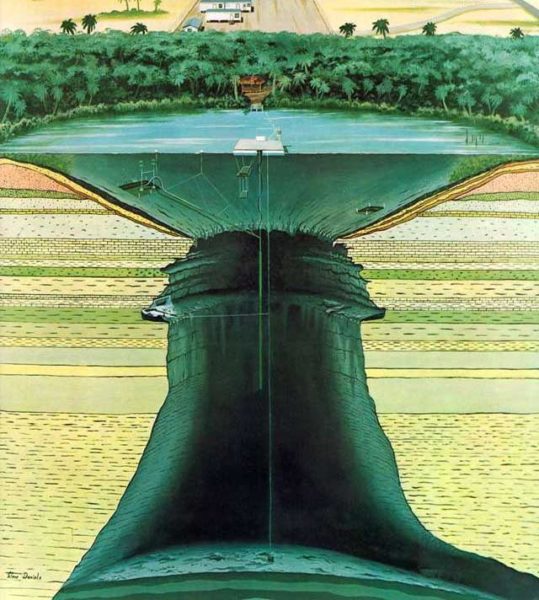WARM MINERAL SPRINGS
 The City of North Port, Florida is home to Warm Mineral Springs, which maintains 85 degrees year round and contains an estimated 51 minerals – one of the highest mineral content of any natural spring in the United States. The surface area of the spring is a round pond 1.4-acre in circumference, which reaches depths of nearly 250 feet in the center.
The City of North Port, Florida is home to Warm Mineral Springs, which maintains 85 degrees year round and contains an estimated 51 minerals – one of the highest mineral content of any natural spring in the United States. The surface area of the spring is a round pond 1.4-acre in circumference, which reaches depths of nearly 250 feet in the center.
The hourglass shaped sinkhole (or cenote) is the results of an apparent earthquake that created the subsurface cave-in some 20,000 years ago. At about 45 feet below the surface there are small ledges that encircle the basin, some of which contain shallow caves. Beneath these ledges the springs body expands to form a large cavity where, at about 148 feet below surface, debris accumulates and forms a "Debris Cone" that is thought to be over 30,000 years old.
The limestone bedrock, from which the sinkhole is formed, comes from marine rock. United States Geological Society hydrologists found the porosity of the limestone formation allowed water interchange with the ground water. Water samples collected from the Floridian Aquifer have revealed that the underground water may have taken 60,000 years to filter through the earth before reaching the surface. The discovery of stalactites and stalagmites found in the caves below the spring’s surface indicates that the underwater caves were dry, probably during the last Ice Age.
It is believed that Warm Mineral Springs dates back to the Ice Age. During exploratory dives in the 1950s, the remains of a prehistoric hunter and seven other humans were discovered in a very well preserved state. Similarly, evidence of several creatures have been extracted from the spring, including saber tooth tigers, giant sloths, tortoises, and even camels. The Springs has been added to the U.S. National Register of Historic Places.
Here are links to recent studies related to Warm Mineral Springs’ history and geology:
LITTLE SALT SPRING
 Little Salt Spring Archaeological and Ecological Preserve is a 112-acre parcel of land owned by the University of Miami, located in south Sarasota County in the City of North Port, in the state of Florida, USA.
Little Salt Spring Archaeological and Ecological Preserve is a 112-acre parcel of land owned by the University of Miami, located in south Sarasota County in the City of North Port, in the state of Florida, USA.
The site contains a 260-foot wide by 250-foot deep sinkhole [A natural depression in a land surface formed by the dissolution and collapse of a cavern roof. Sinkholes are roughly funnel-shaped and on the order of tens of meters in size. They generally occur in limestone regions and are connected to subterranean passages.] where evidence of Florida's earliest inhabitants has been found in the sediments of the 40-foot deep basin and the 90-foot ledge of the spring.
During the late Pleistocene and early Holocene, 8,600 to 12,000 radio carbon years ago, the site was a wetland oasis in an arid environment attracting extinct animals, such as giant tortoises and ground sloths, as well as the people who hunted them.
In the middle Archaic period, 6,000 - 7,500 years ago when water filled much of the basin, the spring served as an occupation site and mortuary pond where the occupants interred their dead in the peat of the upper basin of the spring and adjacent wetland slough--a fascinating time capsule of Florida's earliest prehistory
